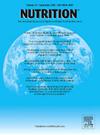段相角可预测男性COPD患者严重加重的发生率。
IF 3.2
3区 医学
Q2 NUTRITION & DIETETICS
引用次数: 0
摘要
目的:探讨段相角(PhA)是否可作为严重慢性阻塞性肺疾病(COPD)恶化的有效预测指标。研究方法和程序:这项前瞻性队列研究招募了COPD患者,随访期为3年。主要终点是严重恶化的发生率。测定全身和节段性身体部位(躯干和上下肢)的PhA。我们使用受试者工作特征(ROC)曲线来确定基于PhA预测恶化的截止值和曲线下面积(AUC)。我们应用Cox比例风险回归分析来估计PhA对严重恶化发生率的独立预后影响。结果:我们分析了108名男性参与者(平均年龄75.1±7.9岁),中位随访时间为1082[643-1103]天,年严重恶化发生率为0.23 /人年。ROC分析显示,全身和节段PhA的AUC分别为:全身:AUC = 0.69(95%可信区间[CI] = 0.59-0.79);右臂:AUC = 0.65 (95% CI = 0.53-0.77);左臂:AUC = 0.68 (95% CI = 0.56-0.79);右腿:AUC = 0.73 (95% CI = 0.64-0.82);左腿:AUC = 0.71 (95% CI = 0.62-0.81);trunk: AUC = 0.58 (95% CI = 0.46-0.69)。Cox比例风险分析显示,右腿(风险比[HR]=3.50, 95% CI=1.33-9.20)、左腿(风险比[HR]= 3.26, 95% CI=1.18-9.04)和左臂(风险比[HR]= 2.61, 95% CI=1.17-6.80)的PhA与严重恶化发生率独立且显著相关。整个和主干PhA与严重恶化发生率无显著相关。结论:节段性PhA可作为男性COPD患者严重加重的有价值的预测指标。值得注意的是,两种腿部PhA与严重恶化的发生密切相关。注册号:UMIN000044824。本文章由计算机程序翻译,如有差异,请以英文原文为准。
Segmental phase angle can predict incidence of severe exacerbation in male patients with COPD
Objective
To investigate whether segmental phase angle (PhA) is a useful predictor of severe chronic obstructive pulmonary disease (COPD) exacerbation.
Research methods and procedures
This prospective cohort study enrolled consecutive patients with COPD with a follow-up period of 3 years. The primary outcome was incidence of severe exacerbation. PhA was measured for the whole body and segmental body sites (trunk and upper and lower limbs). We used receiver operating characteristic (ROC) curves to determine the cut-off values and area under the curve (AUC) for predicting exacerbation based on PhA. We applied Cox proportional hazard regression analyses to estimate the independent prognostic effect of PhA on the incidence of severe exacerbation.
Results
We analyzed 108 male participants (mean age 75.1±7.9 years) and the median follow-up period was 1082 [643–1103] days, with an annual severe exacerbation incidence rate of 0.23 per person-year. ROC analysis revealed that the AUC for Whole-body and segmental PhA were as follows: Whole-body: AUC = 0.69 (95% confidence interval [CI] = 0.59–0.79); right arm: AUC = 0.65 (95% CI = 0.53–0.77); left arm: AUC = 0.68 (95% CI = 0.56–0.79); right leg: AUC = 0.73 (95% CI = 0.64–0.82); left leg: AUC = 0.71 (95% CI = 0.62–0.81); trunk: AUC = 0.58 (95% CI = 0.46–0.69). Cox proportional hazard analysis demonstrated that PhA of the right leg (hazard ratio [HR]=3.50, 95% CI=1.33–9.20), left leg (HR=3.26, 95% CI=1.18–9.04), and left arm (HR=2.61, 95% CI=1.17–6.80) were independently and significantly associated with incidence of severe exacerbation. Whole and trunk PhA were not significantly associated with the incidence of severe exacerbation.
Conclusions
Segmental PhA may serve as a valuable predictive indicator of severe exacerbation in male patients with COPD. Notably, both leg PhA were strongly associated with the occurrence of severe exacerbations.
Registry Number
UMIN000044824.
求助全文
通过发布文献求助,成功后即可免费获取论文全文。
去求助
来源期刊

Nutrition
医学-营养学
CiteScore
7.80
自引率
2.30%
发文量
300
审稿时长
60 days
期刊介绍:
Nutrition has an open access mirror journal Nutrition: X, sharing the same aims and scope, editorial team, submission system and rigorous peer review.
Founded by Michael M. Meguid in the early 1980''s, Nutrition presents advances in nutrition research and science, informs its readers on new and advancing technologies and data in clinical nutrition practice, encourages the application of outcomes research and meta-analyses to problems in patient-related nutrition; and seeks to help clarify and set the research, policy and practice agenda for nutrition science to enhance human well-being in the years ahead.
 求助内容:
求助内容: 应助结果提醒方式:
应助结果提醒方式:


